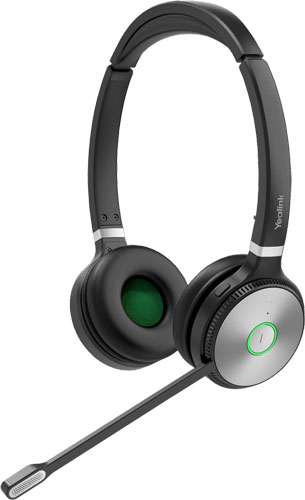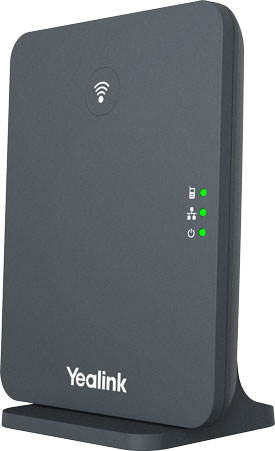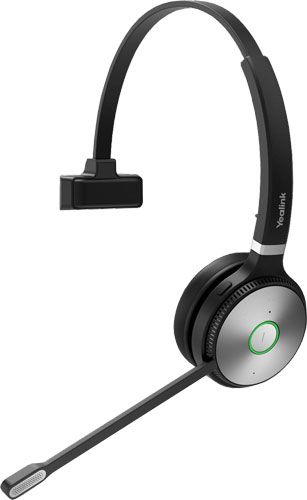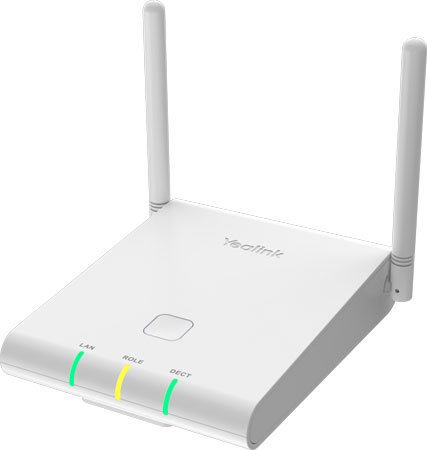Here’s something really cool that you probably don’t know: Yealink Headsets can be paired with Yealink IP base stations.
More specifically, cordless Yealink DECT headsets can be used with the base stations that are typically used for wireless VoIP phones.
By using a wireless headset with a wireless VoIP phone system, you get a vastly expanded wander range. You can walk anywhere the DECT base station and its repeaters reach.
Which is a way, way bigger range than you’d get in any other situation.
In this blog, we cover the benefits of pairing a Yealink DECT headset with a Yealink IP base station. We discuss cool features like Push-to-Talk (PTT), too.
Let’s get into it!

Using a Cordless Headset with a Wireless VoIP Phone System
Let’s start with the basics: what devices does this work for?
As of July 2025, the information in this blog applies to the following Yealink DECT headsets:
- WH62 / WH62 Portable
- WH63 / WH63 Portable
It works with both UC and Microsoft Teams models.
As of July 2025, the information in this blog applies to the following Yealink base stations:
- W70B
- W80B / W80DM
- W90B / W90DM
Another basic question: how is this different from a typical wireless headset setup?
A typical wireless headset is used with a device like a VoIP phone, computer, or smartphone. The headset is simply an audio peripheral.
A Bluetooth headset is used via a direct connection to a device. A DECT headset communicates with a base or DECT dongle that is connected to a device.
What this setup means is that the headset must be within a certain distance of the connected device.
A DECT headset paired with a DECT base station is the same basic setup: a headset connected to a device.
But — and this is the key thing — a DECT base station can be part of a wireless phone system that covers vastly more space than a single Bluetooth connection or even a DECT base or dongle.
The DECT base station can cover more space because of repeaters or via a multi-cell DECT phone system.

Expanded Wireless Range
Let’s talk about wireless headset range.
A Bluetooth headset will typically have a range of around 100 feet at best. A DECT headset is much better, with line-of-sight connectivity up to around 500 feet or so.
However, with both types, any obstacle like a wall, cubicle divider, or person can greatly reduce the range. The ranges companies give you are always best-case scenarios.
So, unless you’re wearing a headset in a large, empty field, the actual range is going to be much, much less. In real world conditions, a Bluetooth headset won’t have a good range beyond about 30 feet.
This limited range is more than enough for most workers, because we tend not to wander that far from our desks or phones.
But.
What if you work in a larger place like a warehouse, factory, hangar, automotive center, or box store?
Wouldn’t it be great to be able to be anywhere in the building and still be able to answer a call from your business’s VoIP phone?
That’s the promise of pairing a DECT headset with an IP base station.

Registering a Yealink Headset with a Yealink DECT Phone System
First off, if you want complete instructions on how to register a Yealink DECT headset with a Yealink wireless phone system, visit the Yealink Knowledge Base (external links):
- Register Devices to W70B: Headset Registration
- Register Devices to W80DM/W90DM: Headset Registration
Pairing a headset works in one of two ways:
- The headset is registered in the system as a DECT handset. It has its own line.
- The headset is given the same extension as a DECT handset already registered in the system. This is called a shared line.
In either case, the DECT headset is now registered to place and receive calls on a specific extension in the wireless VoIP phone system.
Your wireless headset is now, essentially, a wireless phone.

Features of Pairing a DECT Headset to a Wireless Phone System
Your headset is paired. How does it work?
The compatible Yealink DECT headsets have call controls on the headset itself: call answer/end, volume, etc.
You just answer calls that are directed to the headset’s extension like you would use the headset at any other time. When you hear the ring, you press the call button.
That’s not all, though.
Via the phone system backend, you can set a customized speed dial extension that the headset can call via a double-tap of the call button. (You can only set one speed dial extension.) This button can also work for redial.
The headset can also be set to automatically answer intercom calls.

Push-to-Talk Calls
The headset can also be used as a walkie-talkie in Push-to-Talk (PTT) mode. This greatly expands the range of a walkie-talkie, too.
PTT can be setup for groups, so you could have workers with a mix of handsets and headset on the same PTT group.
If you have a team of workers in a warehouse or hangar, for example, all of you can keep in touch through the wireless base stations. You can always be able to hear the group conversation, too, because it’ll be in your headset.
And, crucially, the conversation will be private, as compared with a handheld walkie-talkie.

